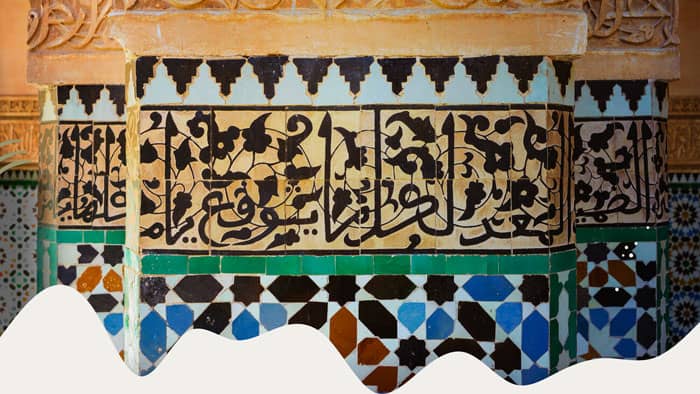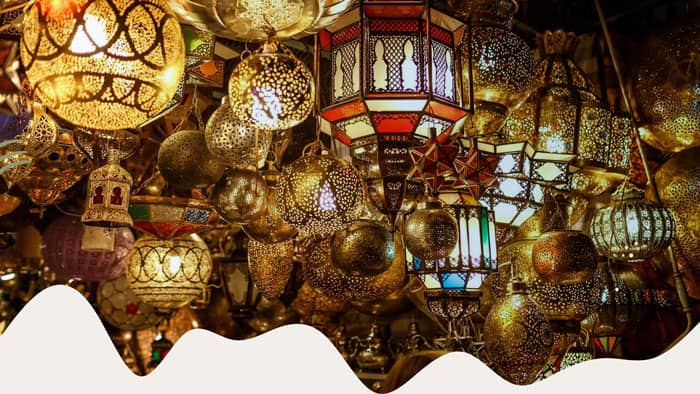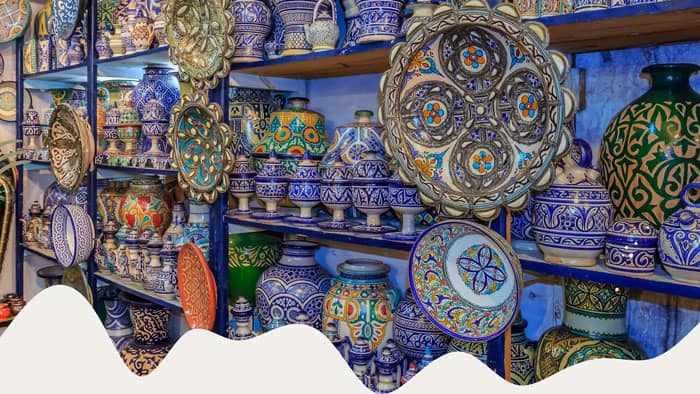
Calligraphy, Metalwork, and Ceramics: Morocco’s Living Art Forms
Introduction: The Soul of Moroccan Art
Traditional Moroccan Art is alive in every corner of Morocco, from the winding alleys of Fez to the sun-drenched souks of Marrakech. In this country, creativity is woven into daily life, and craftsmanship is more than an occupation — it is an inheritance, a spiritual dialogue between the artisan and the material. Every brushstroke, hammer tap, or glaze reflects centuries of tradition, patience, and devotion.
At the heart of this enduring legacy are the country’s most celebrated forms of traditional Moroccan art — calligraphy, metalwork, and ceramics. These crafts form the soul of Morocco’s aesthetic identity, echoing Arab, Berber, and Andalusian influences that have shaped the nation for over a millennium. They speak of faith and geometry, rhythm and repetition, and a deep respect for beauty in the everyday.
Calligraphy transforms words into visual poetry, infusing spiritual meaning into architectural spaces and sacred manuscripts. Metalwork gives form to light itself — from intricately pierced lanterns that dance with shadows to elegant trays and teapots that symbolize Moroccan hospitality. Ceramics, born of earth and fire, adorn homes, mosques, and palaces with mesmerizing color and pattern, uniting artistry and function in every piece.
What makes these arts truly remarkable is that they are living traditions. The skills and secrets of each craft are passed from master (maalem) to apprentice, generation after generation. While rooted in ancient techniques, today’s artisans continue to innovate, blending classic motifs with contemporary design. This balance between preservation and creativity ensures that traditional Moroccan art remains vibrant and relevant in the modern world.
In this journey through traditional Moroccan art, we’ll explore how calligraphy, metalwork, and ceramics reflect Morocco’s history, spirituality, and craftsmanship — and how these timeless arts continue to shape the country’s cultural identity today.
The Sacred Beauty of Moroccan Calligraphy
1. Origins and Spiritual Meaning
Calligraphy holds a sacred place in Moroccan art — a visual embodiment of faith, intellect, and beauty. Rooted in the Islamic tradition where depicting human figures was discouraged in religious contexts, calligraphy became the highest form of artistic expression, transforming divine words into mesmerizing patterns of ink and rhythm.
In Morocco, this art form blossomed into a distinctive style known as Maghrebi script — a rounded, flowing variation of Arabic calligraphy that developed in the western Islamic world (North Africa and Andalusia). Unlike the angular Kufic or elongated Thuluth scripts found in the Middle East, the Maghrebi style reflects Morocco’s fluid sense of form and balance, often marked by bold loops, deep curves, and harmonious spacing.
Calligraphy was not merely decorative; it was devotional. Each stroke of the pen was considered an act of worship, a meditative practice that required patience and spiritual focus. From Qur’anic manuscripts to architectural inscriptions, calligraphy infused Moroccan spaces with both meaning and beauty — reminding viewers of the divine through artistry.

2. Tools and Techniques
The art of calligraphy demands both precision and grace. Traditional Moroccan calligraphers use a reed pen (qalam) carefully cut to control the flow of ink, and they prepare their own pigments from natural materials such as soot, walnut shells, or minerals. Writing surfaces range from smooth parchment to handmade paper, each chosen for its ability to absorb ink evenly.
Training is rigorous and often spiritual in nature. Apprentices study under a master (maalem), learning to balance composition, proportion, and rhythm. Each letter and curve must be perfectly aligned — not just technically, but emotionally. The goal is harmony: a written form that pleases the eye and nourishes the soul.
3. Modern Applications
While deeply traditional, Moroccan calligraphy has gracefully entered the modern age. Its influence extends beyond manuscripts into architecture, design, and contemporary art. Visitors can admire exquisite inscriptions adorning the walls of mosques like the Koutoubia Mosque in Marrakech or the Al-Qarawiyyin Mosque in Fez, where verses from the Qur’an appear in stone and tile, framing sacred spaces with visual poetry.
Today, Moroccan artists and designers are breathing new life into the craft. Calligraphic motifs appear on ceramics, textiles, jewelry, and digital art, merging centuries-old techniques with contemporary aesthetics. Young calligraphers experiment with vibrant colors, abstract compositions, and even street murals, reimagining the script as a form of cultural expression in the modern world.
Through this evolving dialogue between past and present, Moroccan calligraphy remains a living art form — one that continues to honor its sacred origins while speaking to new generations in fresh and inspiring ways.
Metalwork: Crafting Light and Legacy
1. Ancient Roots and Regional Styles
Few crafts capture the Moroccan sense of precision and poetry quite like metalwork. Its origins date back centuries — to the Almoravid and Almohad dynasties — when Morocco became a crossroads of trade, skill, and design between Africa, Europe, and the Arab world. Over time, Moroccan artisans developed unique regional styles that reflected both local identity and global influence.
-
Fez became renowned for fine brass and copper engravings — intricate trays, teapots, and lamps that shimmered with delicate patterns.
-
Marrakech specialized in ornate lanterns and decorative metal screens that filled riads and palaces with light and shadow.
-
Essaouira, with its coastal roots, became known for silver jewelry and filigree work inspired by both Berber and Andalusian motifs.
Each city contributed a distinctive artistic signature, but all shared one principle: beauty born from craftsmanship and patience.

2. Techniques and Materials
Metalworking in Morocco is a symphony of sound and precision — the rhythmic tapping of hammers echoing through medinas as artisans bring lifeless metal to life. Traditional craftsmen, known as maalems, work with brass, copper, silver, and bronze, shaping each piece by hand in small, family-run workshops.
The process is entirely manual. Sheets of metal are cut, heated, and hammered into form before being engraved with complex geometric or floral patterns. Designs are often guided by Islamic art principles — repetition, symmetry, and infinite pattern — reflecting divine perfection.
Techniques such as:
-
Engraving (naqch) — carving intricate motifs into the surface.
-
Hammering (taktir) — creating texture and depth.
-
Filigree — twisting thin metal wires into lace-like designs, especially for jewelry and ornaments.
Each finished piece carries the craftsman’s personal touch — small variations that distinguish handmade Moroccan metalwork from mass production.
3. Iconic Creations
Moroccan metalwork has given rise to timeless icons of design:
-
Lanterns and lamps: Perhaps the most recognizable, these luminous artworks cast delicate shadows across riad courtyards and medina streets. Their pierced patterns turn light into magic, transforming a simple flame into a dance of geometry.
-
Teapots and trays: Essential symbols of Moroccan hospitality, often made from polished brass or silver, engraved with arabesques or calligraphic inscriptions.
-
Decorative mirrors, doors, and furniture accents: Combining functionality with elegance, blending art seamlessly into daily life.
Each item, no matter how humble, carries a story — of lineage, skill, and devotion.
4. Metalwork in the Modern Era
Though rooted in history, Moroccan metalwork continues to evolve and thrive. Modern artisans are finding ways to balance tradition with innovation — adapting age-old motifs to contemporary interiors, hotels, and international markets.
In cities like Fez and Marrakech, craft cooperatives and design studios collaborate to preserve the craft while opening it to new audiences. Contemporary designers incorporate Moroccan metalwork into minimalist décor — merging raw brass with modern geometry, or pairing traditional lanterns with sleek architecture.
Beyond aesthetics, this revival sustains local economies and preserves cultural identity. Each piece of handcrafted metalwork connects Morocco’s past to its future, proving that artistry, when nurtured, never fades — it simply transforms with time.
Ceramics: Earth, Fire, and Color
1. Ancient Art, Ever-Evolving
Among all Moroccan crafts, ceramics may best reflect the country’s deep connection to the earth itself. Born from clay, shaped by hand, and transformed by fire, Moroccan pottery embodies the union of nature and creativity. Its origins trace back to Berber traditions long before Islam arrived in North Africa, later enriched by Andalusian and Arab influences during centuries of cultural exchange.
By the medieval period, Moroccan ceramics had developed into a refined art form, celebrated for its beauty and practicality. Across the country, different regions became famous for their distinctive styles:
-
Fez — known for its elegant blue-and-white pottery, inspired by Andalusian design and Chinese porcelain.
-
Safi — the vibrant coastal city that became Morocco’s leading ceramic hub, producing colorful earthenware with intricate geometric and floral motifs.
-
Meknes and Marrakech — centers of tile and mosaic (zellij) craftsmanship, where clay meets architecture in dazzling displays of geometry.
Each region tells its own story through color, shape, and pattern — a story that continues to evolve today.

2. The Crafting Process
Creating Moroccan ceramics is a labor of patience, precision, and rhythm. It begins with selecting the right clay, often gathered from local riverbeds. The artisan kneads it to remove air pockets, then shapes it by hand or on a traditional potter’s wheel (roue de potier). Once shaped, the piece is left to dry in the sun, sometimes for days, before undergoing its first firing in a kiln.
After cooling, the piece is glazed and hand-painted, often using mineral-based pigments that produce rich blues, greens, yellows, and browns. The final firing fuses color and glaze, creating that distinctive Moroccan sheen.
Patterns are not chosen at random — they carry deep symbolic meaning. Geometric designs represent unity and infinity, floral motifs symbolize growth and beauty, while arabesques evoke divine harmony. Every curve and line reflects a cultural dialogue between faith, mathematics, and imagination.
3. Iconic Designs and Motifs
-
Fez Blue: The city’s signature cobalt blue is the hallmark of its pottery — elegant, restrained, and instantly recognizable. Fez artisans often combine this blue with white backgrounds and fine arabesques.
-
Safi Ceramics: Characterized by bold colors, circular patterns, and floral inspirations, Safi’s pottery brings warmth and vibrancy to Moroccan homes.
-
Zellij Tilework: Perhaps Morocco’s most intricate ceramic expression, zellij mosaics adorn fountains, palace walls, and mosques. Each tile (ferka) is hand-cut and arranged to form stunning geometric compositions that symbolize the infinite nature of creation.
These designs have transcended centuries, influencing global art and design while retaining their Moroccan soul.
4. Preservation and Innovation
While many artisans still follow traditional techniques, modern Moroccan ceramics have found a new life in contemporary design. Today’s artists blend tradition with creativity — experimenting with new color palettes, shapes, and applications that appeal to both local and international audiences.
In Safi, cooperatives support young potters and women artisans, ensuring that ancestral skills continue to thrive. In Fez, workshops such as those near the Bab Ftouh Gate welcome visitors to witness the process firsthand — from raw clay to finished masterpiece.
Meanwhile, designers and architects integrate Moroccan ceramics into modern spaces — from riad courtyards to luxury hotels — proving that this ancient art remains as functional as it is timeless.
Ultimately, Moroccan ceramics are not just objects of beauty; they are vessels of heritage. Each bowl, vase, or tile carries centuries of knowledge, belief, and craftsmanship — a reminder that Morocco’s artistic legacy is molded from both earth and spirit.
Experience Morocco’s Living Art Forms for Yourself!
Step beyond the souks and discover Morocco through its living crafts — from hand-painted ceramics in Fez to glowing metal lanterns in Marrakech and elegant calligraphy in Rabat. Visit artisan workshops, meet master craftsmen, and even try your hand at creating your own Moroccan keepsake. Let these timeless arts inspire your next adventure!
The Role of Moroccan Artisans in Cultural Identity
1. The Guardians of Heritage
In Morocco, artisans are more than skilled workers — they are guardians of cultural memory. Each maalem (master craftsman) holds centuries of inherited knowledge, passed down from teacher to apprentice in an unbroken chain of tradition. These masters preserve not just techniques, but values: patience, respect for materials, and a deep sense of pride in creating beauty by hand.
This reverence for craftsmanship defines Moroccan identity. In medinas across Fez, Marrakech, and Meknes, the rhythmic sounds of hammering metal, painting ceramics, or inscribing calligraphy remind visitors that Morocco’s artistic heart is still beating. Every crafted object, whether a lantern or a teapot, carries with it the fingerprints of its maker — a connection between past and present that mass production can never replicate.
2. The Socio-Economic Importance of Artisanship
Artisanal crafts are also the economic lifeblood of many Moroccan communities. The craft sector employs hundreds of thousands of people, particularly in rural areas where access to other industries is limited. Cooperatives, often run by families or women’s groups, play a crucial role in preserving these traditions while empowering artisans to earn a sustainable living.
Cities like Fez, Marrakech, and Safi have developed artisan cooperatives where craftspeople share resources, access fair trade markets, and attract visitors interested in authentic Moroccan craftsmanship. Through these initiatives, traditional arts are not only surviving — they are thriving, adapting to global demand while maintaining their cultural essence.
3. Recognition and Preservation Efforts
The Moroccan government and international organizations have long recognized the importance of preserving these artistic traditions. UNESCO has included elements of Moroccan craftsmanship — such as the Medina of Fez — and the Marrakech Medina as World Heritage Sites, celebrating their artistic and cultural value.
The Maison de l’Artisan (House of the Artisan) in Rabat works to promote crafts globally, offering training, exhibitions, and international exposure for local artists. Cultural festivals like the Festival of Traditional Arts in Marrakech showcase the diversity and creativity of Moroccan artisans, helping to keep their skills visible and relevant.
Such recognition not only validates centuries of work but also inspires younger generations to see craftsmanship as a source of pride and opportunity.
4. Tradition Meets Modernity
What keeps Morocco’s artistic identity so dynamic is its ability to blend heritage with innovation. Younger artisans are experimenting with new materials, minimalist aesthetics, and sustainable production techniques — all while maintaining the soul of their traditions.
Modern Moroccan designers collaborate with global brands, introducing the world to the elegance of handmade lanterns, mosaic tiles, and calligraphic art. These creations are no longer confined to Morocco’s borders — they adorn homes, hotels, and galleries around the world, spreading the beauty of Moroccan craftsmanship internationally.
Yet, despite modernization, the essence remains unchanged: craftsmanship as a spiritual and cultural act. For Moroccan artisans, to create is to honor their ancestors — and to ensure their legacy continues to shine.
Where to Experience Morocco’s Living Art Forms
For travelers, Morocco is not just a destination — it’s a living museum of artistry. Beyond admiring souvenirs in the souks, visitors can step into workshops, meet artisans, and even try their hand at traditional crafts. Each region offers a unique encounter with the country’s living art forms — from sacred calligraphy to glowing metalwork and vibrant ceramics.
1. Fez: The Timeless Capital of Craftsmanship
Fez is the spiritual and artistic heart of Morocco — a city where every alley whispers the language of tradition. In its medina, one of the oldest in the world, calligraphers, potters, and metalworkers keep centuries-old skills alive.
-
Calligraphy Workshops: Visit the Dar Batha Museum or local art studios near the Al-Qarawiyyin Mosque to see Maghrebi script demonstrations. Some artists offer short courses for visitors who wish to learn the basics of Arabic calligraphy.
-
Metalwork Souks: The Seffarine Square is filled with the melodic clang of copper and brass. Here, you can watch craftsmen shaping teapots, trays, and lanterns using ancient hand tools — a scene that has barely changed for hundreds of years.
-
Fez Ceramics Cooperative: Located just outside the medina, this cooperative shows the full pottery-making process, from clay preparation to hand-painting. Visitors can buy directly from artisans, ensuring fair trade and authenticity.
Fez is, in essence, the living classroom of Moroccan craftsmanship.
2. Marrakech: The Artistic Crossroads
Marrakech is a feast for the senses — and a paradise for art lovers. The souks of the Medina are a labyrinth of workshops where metal glows, clay turns, and calligraphy adorns wood and leather.
-
Souk Semmarine and Souk Haddadine: These bustling quarters showcase traditional metal lanterns, brass mirrors, and hand-engraved trays. Many artisans will let you watch as they work, offering insight into the techniques that make each piece unique.
-
Maison de l’Artisan (House of the Artisan): Located in Gueliz, this government-run institution promotes Moroccan craftsmanship through exhibitions, artisan meetups, and design collaborations.
-
Art Galleries and Boutiques: Modern Marrakech also embraces the contemporary side of Moroccan art. Galleries like David Bloch Gallery or Galerie 127 display how calligraphy and pattern inspire new generations of Moroccan artists.
Here, the traditional and the modern dance in perfect harmony — much like the city itself.
3. Safi: The Ceramics Capital
Perched on Morocco’s Atlantic coast, Safi is the country’s pottery capital, home to hundreds of artisans who have turned clay into beauty for generations.
-
National Ceramic Museum (Dar Sultan): Housed in an old fortress, this museum showcases the evolution of Moroccan ceramics from the Middle Ages to today.
-
Pottery Hill (Colline des Potiers): This area offers a fascinating view of ceramic production — dozens of kilns line the streets, and visitors can observe potters throwing clay, glazing, and firing their work.
-
Workshops and Souvenirs: Many workshops in Safi welcome visitors for hands-on experiences. You can learn to shape your own pottery or paint a tile using traditional geometric patterns.
Safi’s ceramics are a symbol of Moroccan earth transformed — colorful, durable, and filled with spirit.
4. Rabat and Other Modern Art Hubs
Rabat, Morocco’s capital, bridges the gap between heritage and innovation. It is home to institutions and galleries that honor the country’s artistic past while supporting modern interpretations.
-
Mohammed VI Museum of Modern and Contemporary Art: This stunning museum often features exhibitions highlighting traditional Moroccan crafts reimagined through modern design.
-
Galerie Bab Rouah: A historical gallery known for showcasing the best of Moroccan visual arts, including works inspired by calligraphy and traditional motifs.
-
Artisan Cooperatives: Across Rabat and nearby Salé, several cooperatives focus on training artisans, promoting women-led craft projects, and encouraging sustainable art production.
Beyond Rabat, cities like Essaouira, Meknes, and Chefchaouen also offer artistic treasures — from silver jewelry and wood carving to painted ceramics and zellij workshops.
5. Experiencing Moroccan Art Beyond the Workshop
For a deeper appreciation, travelers can join artisan tours or craft residencies, many of which combine cultural immersion with hands-on creativity. Programs in Marrakech, Fez, and Safi allow visitors to work side by side with maalems, learning not only techniques but also the philosophy behind them — humility, patience, and respect for craft.
Even staying in a traditional riad offers an artistic experience — with hand-carved plasterwork, zellij mosaics, and calligraphic details adorning walls and fountains. Every element is a celebration of Moroccan artistry and a reminder that in Morocco, art isn’t observed — it’s lived.
Conclusion: The Eternal Dialogue Between Past and Present
Morocco’s artistic heritage is not frozen in time — it moves, breathes, and evolves. From the rhythmic strokes of a calligrapher’s pen to the glowing lanterns of a metalworker and the painted curves of a Safi ceramic bowl, each creation tells a story of continuity. These are not just crafts; they are living art forms — expressions of identity, spirituality, and resilience that bridge centuries of history.
What makes Morocco’s living art forms so captivating is their ability to balance tradition with transformation. Every generation of artisans honors ancestral techniques while daring to innovate — blending the sacred and the modern, the local and the global. This harmony ensures that Moroccan artistry remains timeless, rooted in the past yet reaching boldly into the future.
Beyond aesthetics, these crafts embody a way of life — one that values mindfulness, patience, and connection to the material world. They remind us that art is not just about creation, but about preservation of soul and story. When you hold a hand-painted bowl from Fez or watch a craftsman etch brass under the Marrakech sun, you are not just witnessing skill — you are touching history, faith, and human spirit.
In the end, Morocco’s calligraphy, metalwork, and ceramics do more than decorate spaces — they illuminate the heart of Moroccan culture. Each pattern, each brushstroke, and each glimmer of light tells a tale of devotion to beauty, heritage, and craftsmanship. And as long as artisans continue to pass their knowledge from hand to hand and heart to heart, Morocco’s living art forms will continue to thrive — forever shaping the soul of the nation and inspiring all who encounter them.
